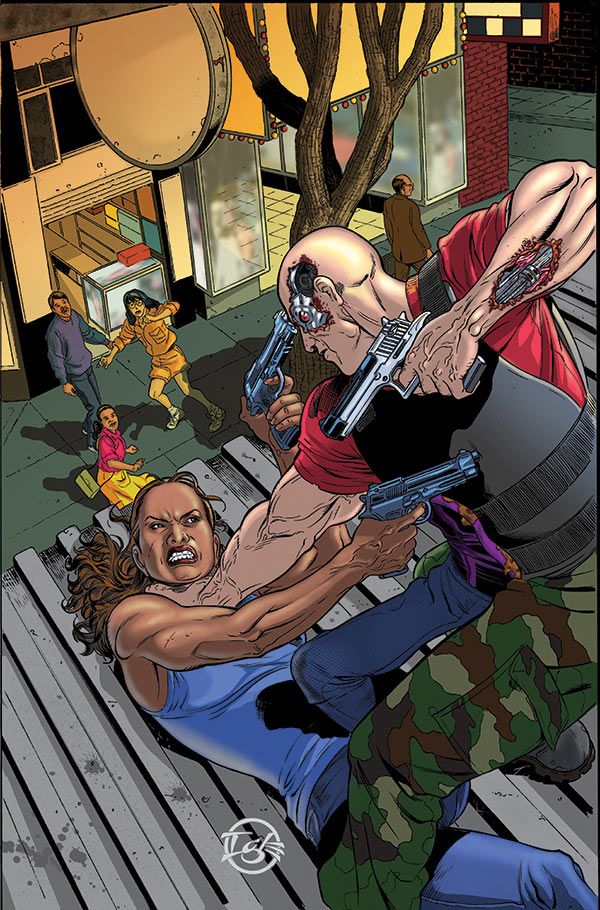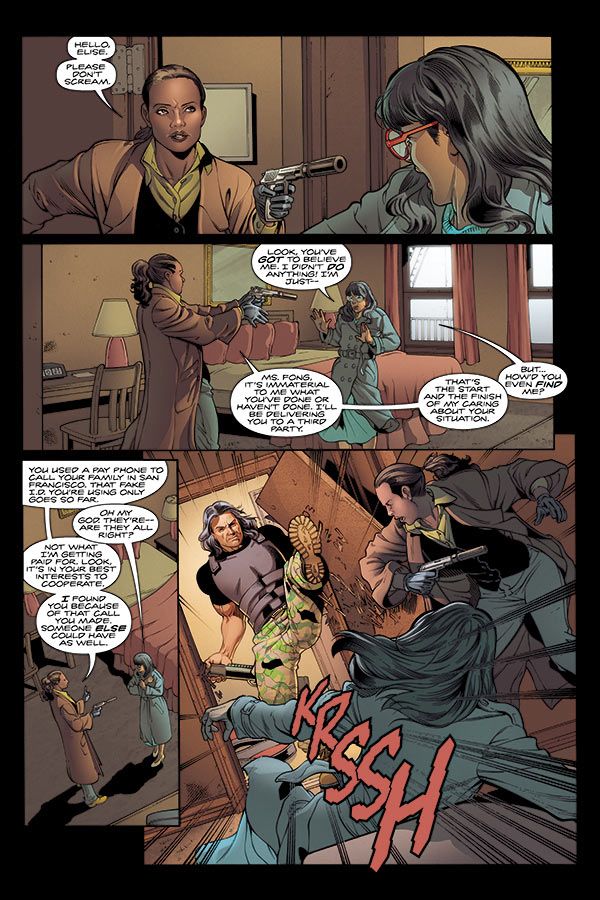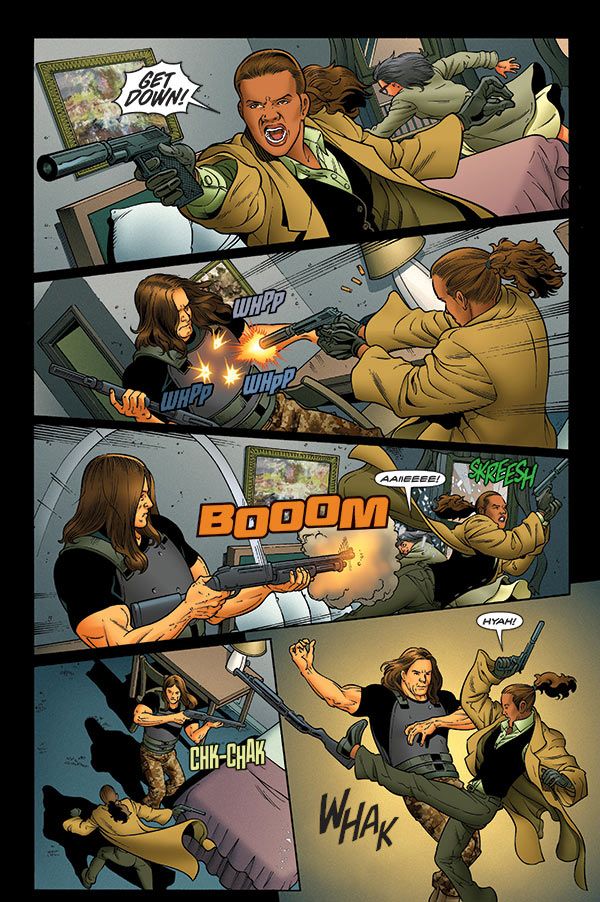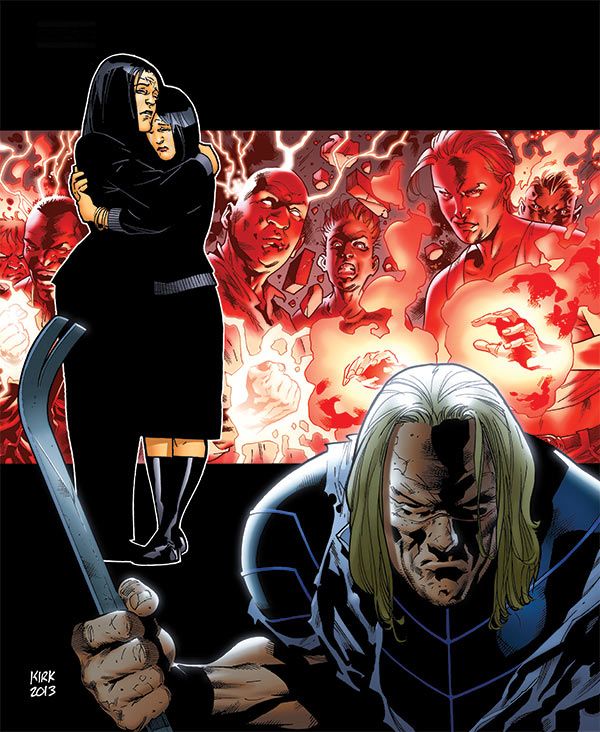Sent from the future to pursue a woman named Sarah Connor, the walking weapon of destruction known as the Terminator first exploded into the pop culture consciousness in 1984. Luckily for Connor -- and the rest of the world -- she had help from a man named Kyle Reese, a future resistance fighter, in defeating the robotic menace. Now, it's 1985, and in Dan Jolley's "Terminator: Enemy of My Enemy," a Terminator once again threatens us all, but this time, there's no resistance fighter to face it down.
Debuting February 19 from Dark Horse Comics, "Enemy of my Enemy" is a six-part miniseries written by Jolley and featuring art by "Molly Danger" creator Jamal Igle. The series' story takes a path both tangential and parallel to the traditional approach to the franchise: This machine is sent back to eradicate a threat to Skynet in the form of a bio-engineer named Elise Fong. With limited resources, the resistance can't protect everyone in the past from Skynet's forces, and as a result, no one knows who or what this Terminator is, or how to stop it.
JMS Explores Skynet in "Terminator: The Final Battle"
Comic Book Resources spoke with Jolley about taking a different approach to the Terminator mythology, as well as his current miniseries "Bloodhound: Crowbar Medicine." As we spoke, it became apparent that some themes resonate across both series: Ordinary people rising to extraordinary occasions and borderline between action and horror.
CBR News: What is the story you're telling in "Terminator: Enemy of my Enemy?" How does this miniseries relate to the film franchise?
Dan Jolley: "Enemy of My Enemy" is a story that returns to what I consider the roots of the franchise, which is to say, the first film. In every "Terminator" story I can think of, there are always three components: The Terminator, the clueless civilian human target and the resistance agent sent back by John Connor to save him or her. What I wanted to do is pose the question, what happens if the resistance isn't able to send anyone back? What if it's just Terminator vs. "uninitiated" humans?
Because of that, this story is set entirely in 1985. No flash-forwards to post-Judgment Day -- it's strictly humans vs. an unstoppable threat that they don't understand. Editor Brendan Wright and I are both really interested in that "fear of the unknown" aspect of the story, and it was reinforced for me when I went back and watched the first movie again before I started on this project; it's an action movie, yes, but there are some serious elements of horror in it. That's what we're trying to touch on.
So, to answer the second part of your question, this story is set firmly in the mythology of the films, but concentrates on a different cast of characters. I never thought Skynet would have only had one target that it wanted to get rid of. This is about a target we simply haven't heard about before, and the humans who get caught up in this Terminator's mission.
With that idea of "the fear of the unknown" -- what about the Terminator, as a creature or character, is frightening? What leads it into the horror genre with that theme?
I remember my impressions of the first movie before it came out. Obviously, it was called "Terminator," and I remember seeing images of this enormous dude in sunglasses coming after Linda Hamilton, and absolutely nothing could stop him. I didn't know anything about Terminators, or Skynet, or anything about the mythology -- it was just, here's this guy, this Terminator, and, to crib from the movie, he absolutely will not stop until you are dead.That's the fear of the unknown in a nutshell. Who is this guy? What is this guy? Why won't bullets stop him? What's his motivation? Y'know -- "What if one of those guys came after me?" It's easy to forget, these days, that movie-going audiences weren't initiated into the whole Terminator lore back then. The Terminator in the first movie had a bit of the Michael Myers, "Halloween" thing going on. He wasn't human. He was like a force of nature, and the only thing he wanted to do was kill Sarah Connor, and for a good chunk of the movie, it was impossible for Sarah to understand why. That's pretty damn terrifying, and I'm trying to convey what that must have felt like in this story.
We've seen a range of Terminator models in the films and other media. With time travel and all, even though your story is set in 1985, any type of Terminator could make an appearance. What model machine appears in "Enemy of My Enemy?"
The Schwarzenegger Terminator was a T-800 series, Model 101. The Terminator in this story is also a T-800, but not the same model, so he doesn't look like Arnold.
Who is your character, Elise Fong? What is she working towards that poses a threat to Skynet?
Elise Fong is a researcher on the verge of a massive breakthrough in lab-grown skin. She's the catalyst that sets everything in motion because, as will be revealed in the story, her work directly affects -- or rather, has the potential to directly affect -- what Skynet does with the development of Terminators themselves. What she's developing has put a huge target on her back, not only from Skynet in the future, but also from a couple of huge pharmaceutical corporations in 1985 who want to see her either controlled or eliminated.
Elise Fong is not the protagonist of the story, though. That role goes to ex-CIA assassin Farrow Greene, a character I described to Jamal as being "half Gina Torres, half Gina Carano." It made sense to me that someone valuable enough or dangerous enough for Skynet to target could also draw a lot of attention from regular humans, and Farrow Greene has accepted the assignment of locating Fong and delivering her to a third party. Greene has some serious problems of her own, and the massive bounty she's planning to collect for bringing Fong in will solve a good chunk of them. The trouble is that she needs Fong alive, while the Terminator wants her dead, so Greene and the Terminator find themselves at cross purposes right off the bat. Greene may not know what the Terminator is or why he wants to kill Elise Fong, but she's one of the few humans alive who can go toe-to-toe with a Terminator and live to tell about it.
Much of the Terminator films, and the television series "The Sarah Connor Chronicles," hinge on the seemingly unlikely hero of Sarah Connor, and the tension between who she is and who she's fated, in a sense, to become. So, to play devil's advocate perhaps -- how do you tell a "Terminator" story without Sarah Connor?
It's really just a question of looking at the mythology from a different angle. If Skynet has the capability of utilizing time travel to eliminate people who pose a threat to it, do we accept that the only person who ever posed a threat was John Connor? If that's the theory you go with, then I could see the entire franchise revolving around Sarah Connor, only. But if you consider that maybe more than one human out of several billion might have been a problem for Skynet, what that means is that there are potentially boatloads of stories about Terminators going after other, unrelated people. This is one of those stories -- and it includes a dynamic involving a Terminator that I don't think we've seen before.
Is it important, or significant, for the protagonist of the Terminator myth to be a woman?
I don't think it's important at all. Greene is very different from Sarah Connor, especially in her background and the skills and training she's already achieved when the story opens, but I never looked at this and said, "Okay, we need to pit a woman against a Terminator, because that's how this franchise works." The protagonist could've been a man. I just enjoy the thought of potentially the most dangerous human on Earth, or at least one of the most dangerous humans, being female. And once I started thinking about who Farrow Greene is, and began layering in her back story, the more fun creating her became, and the more I was convinced it was the right choice for this.
What does Igle bring to the project, and how would you describe your working process?
Jamal and inker Ray Snyder bring vast amounts of talent to "Enemy of My Enemy." I actually requested those two guys specifically, and was lucky enough that they were both able and willing to do the job. Add colorist Moose Baumann, and I know this is going to be a gorgeous book. As far as my working process, with these guys, I just turn over the scripts and watch them go. They sometimes have questions for me or for Brendan, but it's kind of a dream team, much like Leonard Kirk, Robin Riggs and (again) Moose on my creator-owned book "Bloodhound."
Speaking of "Bloodhound," it's also in the midst of a miniseries, "Bloodhound: Crowbar Medicine." How are you feeling about the series so far?
I feel great about it. I'm taking some risks in "Crowbar Medicine" that I wouldn't have had the guts to do a few years ago, and I think it's going to pay off in a big way. Reviewer Chris Partin got his hands on an advance copy of Issue 3, and just pinged me on Twitter yesterday -- he said, "That ending was rough! I was shouting, 'NO!' at the comic!" (I will admit to feeling some sadistic pleasure at that reaction.)
There seems to be a theme one could draw between the two series, something to do with the perils of a techno-biological interface. Clev is facing down the creator of the Power Chip, and Elise is working in bio-tech. What's your interest in this intersection of the human and the machine?
I do have a huge interest in the intersection of the human and the machine, as you put it (I'll be first in line to get some bionic eyes, once they're perfected), but that's not really what I'm going for in either story. What I find fascinating is the concept of regular humans taking on threats that are much, much more dangerous than they are. In "Bloodhound," the main character is a non-powered profiler who hunts down superhuman criminals; in "Enemy of My Enemy," the main character is an ex-CIA operative who's given no choice but to face a cyborg monster from the future. I love stories in which "ordinary" people prove to be ferocious bad-asses. Travis Clevenger and Farrow Greene are very different, but I'd put their badass levels on par with each other.
You mentioned that you're now able to take some risks in "Crowbar Medicine" that a few years ago maybe you couldn't -- seeing those risks pay off, do you feel you're able to continue pushing the envelope? Does that payoff allow you to take more risks, narrative or otherwise, in other projects as well?
Well, the "envelope" is pretty much set by whatever project you're working on. I believe I've gotten better at connecting with readers' emotions in the last several years, and I think that allows you to achieve much more powerful effects in stories. So, if we're talking about writing an original novel, or something else where I'm setting my own rules and boundaries, then yes, I'm definitely going to keep pushing. (There are a couple of things coming up in "Crowbar Medicine"that, if I don't get some angry letters, I'll be a little surprised.)If I get hired to write a story about talking magical sea monkeys, and it's aimed at seven-year-olds, well -- I'll defer to the editor on that one as to what I can get away with.





